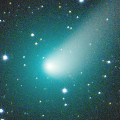
|
Now it is 7.6 mag (May 26, Chris Wyatt). It was expected to brighten up to 6-7 mag from April to July. But it is fainter than predicted recently. In the Northern Hemisphere, it stays observable in excellent condition until June. In the Southern Hemisphere, it becomes observable in good condition after this.
Date(TT) R.A. (2000) Decl. Delta r Elong. m1 Best Time(A, h)
May 27 14 54.21 27 34.6 0.827 1.652 127 6.8 22:32 ( 0, 82)
June 3 14 40.67 20 31.8 0.812 1.642 127 6.7 21:51 ( 0, 75)
|
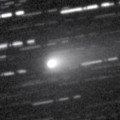
|
Outburst occured on Apr. 4, and it brightened by 2 mag, up to 6.2 mag (Apr. 7, Juan Jose Gonzalez). It is very bright as 7.6 mag still now (May 7, Marco Goiato). It stays observable for a long time after this. But it locates low in the Northern Hemisphere.
Date(TT) R.A. (2000) Decl. Delta r Elong. m1 Best Time(A, h)
May 27 0 41.37 10 0.3 1.341 1.081 52 7.5 3:07 (268, 15)
June 3 1 5.78 12 27.6 1.389 1.117 52 7.7 3:02 (266, 16)
|
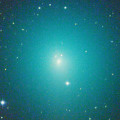
|
It approached to Earth down to 0.14 a.u. from late March to early April, and it brightened up to 6.0 mag (Apr. 7, Juan Jose Gonzalez). Now it is fading. But it is bright as 9.4 mag still now (May 23, Carlos Labordena). It is observable in excellent condition in the Northern Hemisphere. It is observable in good condition after this also in the Southern Hemisphere.
Date(TT) R.A. (2000) Decl. Delta r Elong. m1 Best Time(A, h)
May 27 18 31.27 18 18.4 0.274 1.202 128 9.8 2:14 ( 0, 74)
June 3 18 28.59 13 26.1 0.301 1.249 135 10.6 1:44 ( 0, 69)
|
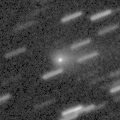
|
Now it is 11.0 mag (May 27, Marco Goiato). It is expected to brighten up to 10 mag in summer. It will be observable in excellent condition in the Southern Hemisphere. It locates low in the Northern Hemisphere.
Date(TT) R.A. (2000) Decl. Delta r Elong. m1 Best Time(A, h)
May 27 16 38.14 -25 52.5 0.609 1.620 172 10.7 0:21 ( 0, 29)
June 3 16 34.91 -27 38.1 0.595 1.608 174 10.6 23:46 ( 0, 27)
|

|
It has not been observed yet in this apparition. The condition of this apparition is worst. It will brighten up to 10 mag in spring, but not observable at all.
Date(TT) R.A. (2000) Decl. Delta r Elong. m1 Best Time(A, h)
May 27 4 50.09 17 37.4 2.167 1.177 9 11.1 20:47 (125,-15)
June 3 5 18.16 17 35.2 2.209 1.220 9 11.4 20:54 (126,-16)
|
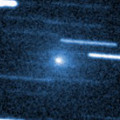
|
Now it is 10.9 mag (Apr. 30, Marco Goiato). It will be fading gradually after this. It is not observable now in the Northern Hemisphere. In the Southern Hemisphere, it stays observable for a long time, but it stays low.
Date(TT) R.A. (2000) Decl. Delta r Elong. m1 Best Time(A, h)
May 27 1 49.11 5 29.2 1.835 1.221 38 13.1 3:07 (262, -2)
June 3 2 9.17 6 16.8 1.895 1.303 40 13.6 3:02 (262, -1)
|

|
Outburst occured on Apr. 23. Now it is bright as 12.5 mag (May 4, Seiichi Yoshida).
Date(TT) R.A. (2000) Decl. Delta r Elong. m1 Best Time(A, h)
May 27 21 41.55 -13 39.7 5.537 5.842 102 13.5 3:07 (320, 32)
June 3 21 42.16 -13 30.8 5.430 5.841 109 13.4 3:02 (325, 34)
|
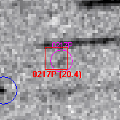
|
Now it is 15.9 mag (May 5, A. Maury, B. Sandness, T. Noel). It will brighten rapidly, and it is expected to brighten up to 12 mag from July to September. In the Southern Hemisphere, it stays at the same altitude in the morning sky. In the Northern Hemisphere, it will be getting higher slowly.
Date(TT) R.A. (2000) Decl. Delta r Elong. m1 Best Time(A, h)
May 27 0 32.78 -1 13.8 1.614 1.391 58 13.8 3:07 (279, 10)
June 3 0 58.68 0 30.0 1.563 1.353 58 13.5 3:02 (277, 10)
|
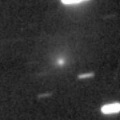
|
Now it is 14.7 mag (Feb. 20, Thomas Lehmann). It is not observable now in the Northern Hemisphere. It will be unobservable temporarily in May also in the Southern Hemisphere. It will be getting higher gradually in the morning sky after summer. Then it will be observable at 11 mag for a long time from 2017 autumn to 2018 winter.
Date(TT) R.A. (2000) Decl. Delta r Elong. m1 Best Time(A, h)
May 27 4 0.44 -10 50.7 5.179 4.356 32 14.0 3:07 (255,-38)
June 3 4 7.01 -9 59.6 5.114 4.304 33 13.9 3:02 (257,-34)
|
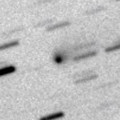
|
Now it is 13.7 mag (May 26, Chris Wyatt). It will brighten up to 14 mag from spring to summer. It locates somewhat low in the Northern Hemisphere. The perihelion distance increased from 2.4 a.u. to 2.9 a.u. in this apparition. So it will not be bright as before.
Date(TT) R.A. (2000) Decl. Delta r Elong. m1 Best Time(A, h)
May 27 16 6.76 -21 29.7 1.983 2.996 178 14.0 23:45 ( 0, 33)
June 3 16 1.26 -21 36.1 1.984 2.988 170 14.0 23:12 ( 0, 33)
|
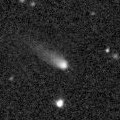
|
Now it is 15.6 mag (Feb. 15, Alexander Baransky). Appearing in the morning sky. It will brighten up to 12-13 mag and will be observable in good condition in summer.
Date(TT) R.A. (2000) Decl. Delta r Elong. m1 Best Time(A, h)
May 27 0 20.60 15 32.8 3.337 2.889 55 14.1 3:07 (266, 22)
June 3 0 18.42 15 44.4 3.188 2.865 62 14.0 3:02 (269, 27)
|
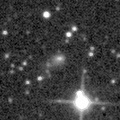
|
Now it is 14.7 mag (Apr. 22, Yuji Ohshima). It will be observable at 14 mag for a long time from 2017 to 2018.
Date(TT) R.A. (2000) Decl. Delta r Elong. m1 Best Time(A, h)
May 27 18 27.69 17 29.9 3.695 4.409 129 14.7 2:11 ( 0, 72)
June 3 18 17.42 18 54.0 3.623 4.377 132 14.6 1:33 ( 0, 74)
|
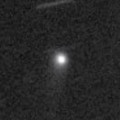
|
Appearing in the morning sky. In the Northern Hemisphere, it will brighten up to 14 mag from summer to winter, and it will be observable in excellent condition. In the Southern Hemisphere, it will be observable in the very low sky only from May to June.
Date(TT) R.A. (2000) Decl. Delta r Elong. m1 Best Time(A, h)
May 27 0 26.28 29 4.3 3.906 3.376 51 14.7 3:07 (252, 27)
June 3 0 30.38 31 25.8 3.807 3.355 56 14.7 3:02 (252, 32)
|
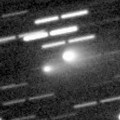
|
It brightened up to 11.5 mag from late March to early April (Mar. 24, Andrew Pearce). Now it is fading. It has already faded down to 15.6 mag (May 6, CAO, San Pedro de Atacama). Bright 12-mag new fragment BT was discovered on Feb. 10, but now it is faint as 16.7 mag (Apr. 18, F.-J. Hambsch, E. Bryssinck). In the Southern Hemisphere, it stays observable for a long time after this. In the Northern Hemisphere, it is not observable temporarily until mid June.
Date(TT) R.A. (2000) Decl. Delta r Elong. m1 Best Time(A, h)
May 27 1 16.32 -1 7.9 1.808 1.376 49 14.8 3:07 (272, 1)
June 3 1 32.25 0 15.4 1.832 1.439 51 15.1 3:02 (272, 3)
|
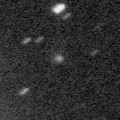
|
Now it is 16.2 mag (May 2, D. Buczynski). It is expected to brighten up to 9 mag in summer in 2018. In the Northern Hemisphere, it stays observable until 2018 summer while the comet will be brightening. In the Southern Hemisphere, it is hardly observable in 2017, but it will be observable in good condition in 2018.
Date(TT) R.A. (2000) Decl. Delta r Elong. m1 Best Time(A, h)
May 27 18 46.45 53 52.2 4.828 5.071 98 15.5 2:29 (180, 71)
June 3 18 38.27 54 5.8 4.742 5.014 99 15.4 1:53 (180, 71)
|

|
Now it is 15.6 mag (Mar. 6, Kunihiro Shima). Now it is not observable. But it will appear in the morning sky in June in the Southern Hemisphere, or in July in the Northern Hemisphere. Then it stays observable at 15.5 mag unil the end of 2017.
Date(TT) R.A. (2000) Decl. Delta r Elong. m1 Best Time(A, h)
May 27 2 40.61 4 7.6 6.411 5.542 28 15.5 3:07 (255,-13)
June 3 2 46.57 4 21.3 6.383 5.566 33 15.5 3:02 (258, -9)
|
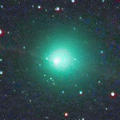
|
Now it is fading rapidly. It has already faded down to 12.3 mag (Apr. 28, Chris Wyatt). In the Southern Hemisphere, it stays observable in good condition after this while the comet will be fading. It locates low in the Northern Hemisphere.
Date(TT) R.A. (2000) Decl. Delta r Elong. m1 Best Time(A, h)
May 27 22 53.72 -17 22.7 1.185 1.527 87 15.6 3:07 (307, 18)
June 3 22 51.04 -17 49.6 1.175 1.618 95 15.9 3:02 (313, 22)
|

|
Now it is 16.8 mag (Apr. 7, MASTER-OAFA Observatory). It will brighten up to 15.5 mag in summer. It will be observable in excellent condition in the Southern Hemisphere. In the Northern Hemisphere, it stays unobservable for some more time.
Date(TT) R.A. (2000) Decl. Delta r Elong. m1 Best Time(A, h)
May 27 21 55.46 -40 15.2 2.050 2.540 107 16.1 3:07 (332, 7)
June 3 22 1.05 -39 28.8 1.965 2.525 111 16.0 3:02 (334, 9)
|
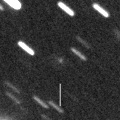
|
Now it is 16.3 mag (Apr. 30, T. Ikemura, H. Sato). It is expected to brighten up to 11-12 mag from 2018 to 2019. In the Northern Hemisphere, it stays observable in good condition while the comet will be brightening gradually. In the Southern Hemisphere, it is not observable until 2018 October.
Date(TT) R.A. (2000) Decl. Delta r Elong. m1 Best Time(A, h)
May 27 17 37.32 59 8.1 4.641 4.884 97 16.2 1:20 (180, 66)
June 3 17 22.89 60 12.0 4.600 4.832 97 16.1 0:38 (180, 65)
|

|
Now it is 15.3 mag (Apr. 23, Yuji Ohshima). It stays 16-17 mag for a long time from 2016 to 2019. It stays near by the equator.
Date(TT) R.A. (2000) Decl. Delta r Elong. m1 Best Time(A, h)
May 27 9 12.87 6 56.4 9.822 9.575 73 16.1 20:47 ( 77, 29)
June 3 9 15.14 7 0.7 9.925 9.573 66 16.1 20:54 ( 82, 23)
|
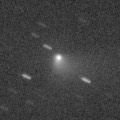
|
Small outburst occured in mid March, and it brightened up to 12.3 mag (Mar. 15, Juan Jose Gonzalez). Now it is fading. It has already faded down to 16.0 mag (Apr. 30, Catalina Sky Survey). It is observable in excellent condition in the Northern Hemisphere. It stays low in the Southern Hemisphere.
Date(TT) R.A. (2000) Decl. Delta r Elong. m1 Best Time(A, h)
May 27 11 39.80 22 11.2 2.398 2.761 100 16.1 20:47 ( 62, 67)
June 3 11 44.43 20 40.6 2.503 2.787 95 16.3 20:54 ( 68, 60)
|

|
It brightened up to 11 mag from spring to summer in 2016. Now it is 17.2 mag (Apr. 30, T. Ikemura, H. Sato). It will be observable at 16-17 mag in good condition from spring to summer.
Date(TT) R.A. (2000) Decl. Delta r Elong. m1 Best Time(A, h)
May 27 20 33.55 -16 53.9 2.437 3.062 119 16.2 3:07 (339, 36)
June 3 20 32.10 -17 0.2 2.391 3.100 126 16.2 3:02 (346, 37)
|

|
It has not been recovered yet in this apparition. It will brighten rapidly, and it is expected to be observable at 15.5 mag in good condition from July to September.
Date(TT) R.A. (2000) Decl. Delta r Elong. m1 Best Time(A, h)
May 27 0 4.95 -18 22.9 2.654 2.548 72 16.3 3:07 (296, 5)
June 3 0 15.09 -17 22.3 2.576 2.543 76 16.2 3:02 (298, 8)
|

|
Now it is 15.7 mag (Apr. 23, D. Buczynski). It stays 16 mag from 2016 to 2017. In the Northern Hemisphere, it stays observable in good condition for a long time. In the Southern Hemisphere, it will never be observable again.
Date(TT) R.A. (2000) Decl. Delta r Elong. m1 Best Time(A, h)
May 27 18 56.16 61 39.9 6.249 6.349 91 16.3 2:38 (180, 63)
June 3 18 51.87 62 42.1 6.254 6.358 91 16.3 2:06 (180, 62)
|
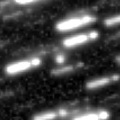
|
It was observed at 17 mag in 2016. In 2017, it will be observable at 15.5 mag in good condition from summer to autumn.
Date(TT) R.A. (2000) Decl. Delta r Elong. m1 Best Time(A, h)
May 27 0 34.46 2 29.8 3.244 2.819 56 16.4 3:07 (275, 12)
June 3 0 43.11 3 45.1 3.167 2.819 61 16.3 3:02 (276, 15)
|
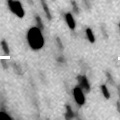
|
Now it is 16.1 mag (May 2, D. Buczynski). It was observed at 16 mag from spring to summer in 2016. It will be observable at 16 mag also in 2017 from winter to spring.
Date(TT) R.A. (2000) Decl. Delta r Elong. m1 Best Time(A, h)
May 27 18 20.53 21 33.6 2.896 3.602 127 16.4 2:03 ( 0, 77)
June 3 18 16.83 23 4.5 2.904 3.632 129 16.5 1:32 ( 0, 78)
|

|
Now it is 17.4 mag (Apr. 30, Thomas Lehmann). It was expected to brighten up to 12 mag in summer. But actually, it is fainter than expected by 3-4 mag. It is observable in excellent condition in the Southern Hemisphere. It locates somewhat low in the Northern Hemisphere.
Date(TT) R.A. (2000) Decl. Delta r Elong. m1 Best Time(A, h)
May 27 19 29.14 -33 12.5 1.343 2.186 135 16.8 3:07 (359, 22)
June 3 19 29.68 -33 6.9 1.274 2.165 141 16.6 2:45 ( 0, 22)
|

|
It stayed bright 12 mag for a long time from autum in 2015 to summer in 2016. Now it is fading. It has already faded dwon to 16.1 mag (Apr. 29, T. Ikemura, H. Sato).
Date(TT) R.A. (2000) Decl. Delta r Elong. m1 Best Time(A, h)
May 27 16 37.92 -12 8.0 4.071 5.070 169 16.9 0:21 ( 0, 43)
June 3 16 31.16 -12 40.5 4.121 5.122 169 17.0 23:42 ( 0, 42)
|

|
It brightened up to 6.2 mag in June in 2016 (June 24, Marco Goiato). Now it is 16.7 mag (Apr. 30, K. Hills). In the Southern Hemisphee, it stays observable in excellent condition after this. It stays low in the Northern Hemisphere.
Date(TT) R.A. (2000) Decl. Delta r Elong. m1 Best Time(A, h)
May 27 12 37.81 -24 58.9 4.288 5.002 130 17.2 20:47 ( 8, 30)
June 3 12 33.27 -23 58.5 4.445 5.068 122 17.3 20:54 ( 18, 29)
|
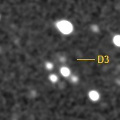
|
Now it is 16.6 mag (Apr. 29, T. Ikemura, H. Sato). It is observable at 17 mag in good condition in spring. It locates somewhat low in the Northern Hemisphere.
Date(TT) R.A. (2000) Decl. Delta r Elong. m1 Best Time(A, h)
May 27 11 56.47 -15 3.0 4.411 4.977 118 17.2 20:47 ( 22, 37)
June 3 11 53.84 -13 31.4 4.524 4.979 111 17.2 20:54 ( 33, 35)
|
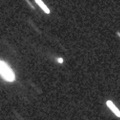
|
Now it is 16.3 mag (Apr. 30, T. Ikemura, H. Sato). It brightened rapidly, and became brighter than originally expected. It stays 16-17 mag until 2017. In the Northern Hemisphere, it stays observable in excellent condition for a long time. It is not observable in the Southern Hemisphere.
Date(TT) R.A. (2000) Decl. Delta r Elong. m1 Best Time(A, h)
May 27 11 22.82 55 4.7 7.585 7.508 81 17.3 20:47 (146, 63)
June 3 11 20.35 54 2.1 7.677 7.520 77 17.3 20:54 (138, 59)
|
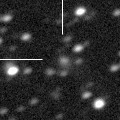
|
Now it is 17.2 mag (Apr. 30, P. Camilleri, H. Williams). In the Southern Hemisphere, it is observable at 17 mag in good condition in spring. It stays extremely low in the Northern Hemisphere.
Date(TT) R.A. (2000) Decl. Delta r Elong. m1 Best Time(A, h)
May 27 12 38.34 -35 50.2 5.202 5.915 130 17.3 20:47 ( 6, 19)
June 3 12 38.16 -34 33.4 5.268 5.915 125 17.3 20:54 ( 14, 19)
|
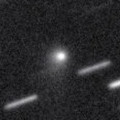
|
It brightened up to 15 mag in early 2016. Now it is fading. It has already faded down to 17.0 mag (Apr. 29, T. Ikemura, H. Sato). In the Northern Hemisphere, it stays observable in good condition for a long time until autumn when the comet will be fainter than 18 mag. It will never be observable after this in the Southern Hemisphere.
Date(TT) R.A. (2000) Decl. Delta r Elong. m1 Best Time(A, h)
May 27 13 43.97 68 17.6 6.790 6.800 86 17.5 21:23 (180, 57)
June 3 13 39.02 67 15.0 6.860 6.832 84 17.5 20:54 (179, 58)
|

|
It stays 15 mag from 2018 to 2019, and it will be observable for a long time in the Southern Hemisphere. In the Northern Hemisphere, it is observable only until June.
Date(TT) R.A. (2000) Decl. Delta r Elong. m1 Best Time(A, h)
May 27 11 59.48 -26 48.1 5.822 6.416 121 17.6 20:47 ( 17, 26)
June 3 11 57.90 -26 39.6 5.869 6.375 115 17.6 20:54 ( 25, 24)
|
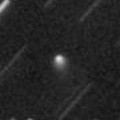
|
It has been 17 mag from 2016 to 2017. It stays bright even after the perihelion passage. It is bright as 16.9 mag still now (May 3, Mt. Lemmon Survey). It is observable in excellent condition in the Northern Hemisphere. It locates somewhat low in the Southern Hemisphere.
Date(TT) R.A. (2000) Decl. Delta r Elong. m1 Best Time(A, h)
May 27 15 17.17 30 36.8 7.223 7.866 126 17.6 22:56 ( 0, 86)
June 3 15 13.65 30 56.2 7.304 7.896 122 17.6 22:25 ( 0, 86)
|
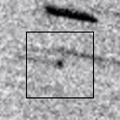
|
Although it was predicted to be fainter than 21 mag, an outburst occured and now it is very bright as 16.5 mag (May 1, T. Ikemura, H. Sato). It stays observable in good condition for a while.
Date(TT) R.A. (2000) Decl. Delta r Elong. m1 Best Time(A, h)
May 27 13 13.38 -18 6.6 2.572 3.387 137 17.7 20:53 ( 0, 37)
June 3 13 11.77 -17 37.3 2.682 3.426 130 17.9 20:54 ( 9, 37)
|
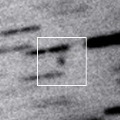
|
It stays observable at 18 mag from spring to summer. It is observable in excellent condition in the Southern Hemisphere. In the Northern Hemisphere, it stays low for a while.
Date(TT) R.A. (2000) Decl. Delta r Elong. m1 Best Time(A, h)
May 27 22 29.22 -33 57.6 5.090 5.341 98 17.8 3:07 (323, 9)
June 3 22 30.94 -33 54.1 5.013 5.361 104 17.8 3:02 (326, 11)
|

|
It has not been observed since last April. Now it is fading. But it must be bright as 17.5 mag still now.
Date(TT) R.A. (2000) Decl. Delta r Elong. m1 Best Time(A, h)
May 27 16 38.90 -15 23.4 2.712 3.718 171 17.9 0:22 ( 0, 40)
June 3 16 33.36 -15 2.1 2.779 3.787 172 18.0 23:44 ( 0, 40)
|
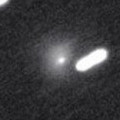
|
Very far object. Outburst occured on Feb. 20, 2015, and it brightened up to 15 mag. Now it is 18.0 mag (Apr. 29, T. Ikemura, H. Sato). It is observable in excellent condition in the Southern Hemisphere. It locates low in the Northern Hemisphere.
Date(TT) R.A. (2000) Decl. Delta r Elong. m1 Best Time(A, h)
May 27 14 24.82 -24 35.3 8.505 9.429 154 17.9 22:04 ( 0, 30)
June 3 14 23.32 -24 17.9 8.562 9.435 147 17.9 21:35 ( 0, 31)
|

|
Now it is 18.4 mag (May 5, Mt. Lemmon Survey). It will be brightening slowly until autumn when it becomes 16.5-17 mag. It will be getting lower gradually in the Northern Hemisphere.
Date(TT) R.A. (2000) Decl. Delta r Elong. m1 Best Time(A, h)
May 27 14 24.93 -10 35.0 1.694 2.629 151 18.0 22:04 ( 0, 44)
June 3 14 20.01 -10 30.5 1.707 2.595 143 17.9 21:31 ( 0, 44)
|
|
![]()
 C/2017 E1 ( Borisov )
C/2017 E1 ( Borisov ) 29P/Schwassmann-Wachmann 1
29P/Schwassmann-Wachmann 1 217P/LINEAR
217P/LINEAR C/2016 R2 ( PanSTARRS )
C/2016 R2 ( PanSTARRS ) 65P/Gunn
65P/Gunn C/2015 VL62 ( Lemmon-Yeung-PanSTARRS )
C/2015 VL62 ( Lemmon-Yeung-PanSTARRS ) C/2015 O1 ( PanSTARRS )
C/2015 O1 ( PanSTARRS ) C/2016 N4 ( MASTER )
C/2016 N4 ( MASTER ) 73P/Schwassmann-Wachmann 3
73P/Schwassmann-Wachmann 3 C/2016 M1 ( PanSTARRS )
C/2016 M1 ( PanSTARRS ) C/2011 KP36 ( Spacewatch )
C/2011 KP36 ( Spacewatch ) 2P/Encke
2P/Encke C/2017 D2 ( Barros )
C/2017 D2 ( Barros ) C/2016 N6 ( PanSTARRS )
C/2016 N6 ( PanSTARRS ) C/2014 B1 ( Schwartz )
C/2014 B1 ( Schwartz ) 315P/2013 V6 ( LONEOS )
315P/2013 V6 ( LONEOS ) 81P/Wild 2
81P/Wild 2 P/2000 S1 ( Skiff )
P/2000 S1 ( Skiff ) C/2014 OE4 ( PanSTARRS )
C/2014 OE4 ( PanSTARRS ) 47P/Ashbrook-Jackson
47P/Ashbrook-Jackson C/2016 B1 ( NEOWISE )
C/2016 B1 ( NEOWISE ) 213P/Van Ness
213P/Van Ness C/2014 W2 ( PanSTARRS )
C/2014 W2 ( PanSTARRS ) C/2013 X1 ( PanSTARRS )
C/2013 X1 ( PanSTARRS ) C/2017 D3 ( ATLAS )
C/2017 D3 ( ATLAS ) C/2014 R3 ( PanSTARRS )
C/2014 R3 ( PanSTARRS ) C/2017 E3 ( PanSTARRS )
C/2017 E3 ( PanSTARRS ) C/2013 V4 ( Catalina )
C/2013 V4 ( Catalina ) C/2017 B3 ( LINEAR )
C/2017 B3 ( LINEAR ) C/2015 LC2 ( PanSTARRS )
C/2015 LC2 ( PanSTARRS ) 157P/Tritton
157P/Tritton C/2015 H2 ( PanSTARRS )
C/2015 H2 ( PanSTARRS ) C/2015 TQ209 ( LINEAR )
C/2015 TQ209 ( LINEAR ) C/2013 C2 ( Tenagra )
C/2013 C2 ( Tenagra ) 130P/McNaught-Hughes
130P/McNaught-Hughes![]()


































